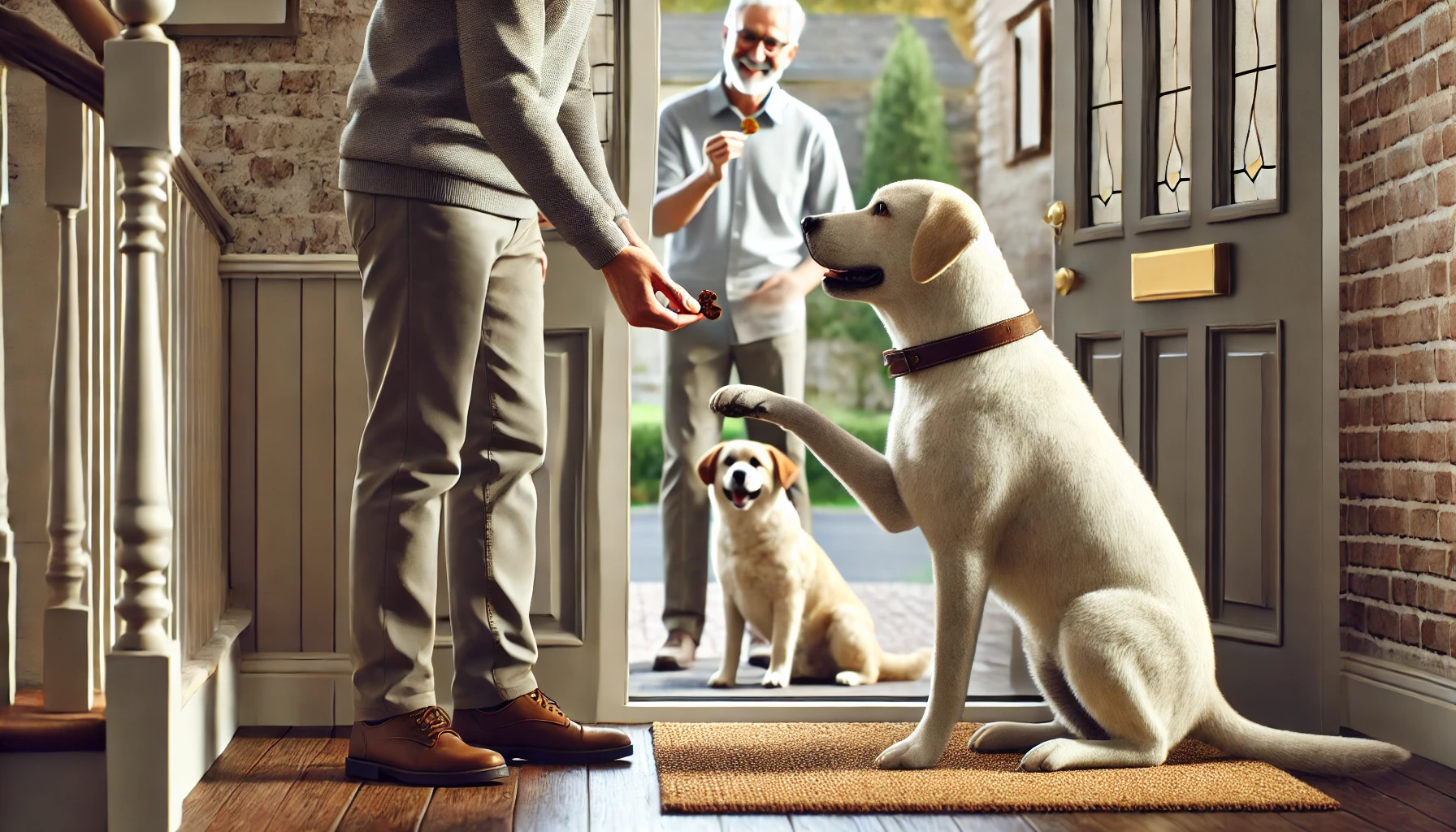Jumping is a common but unwanted behavior in dogs, especially when greeting guests or family members. While some dogs jump out of excitement, others do it to seek attention. Teaching your dog to greet people politely is essential for good manners and safety.
A dog that jumps on people can cause problems, especially if they are large or energetic. They might knock over small children, scratch someone with their paws, or make visitors uncomfortable. Fortunately, with proper training and consistency, you can teach your dog to greet people calmly.
1. Why Do Dogs Jump on People?
Dogs don’t naturally understand that jumping is bad behavior. In fact, many dogs learn that jumping is an effective way to get attention. Understanding why your dog jumps helps you correct the behavior effectively.
1.1 Natural Greeting Behavior
In the wild, puppies lick their mother’s face as a way of greeting. Many dogs carry this instinct into adulthood, jumping up to reach a person’s face.
1.2 Seeking Attention
Dogs quickly learn that jumping gets a reaction. Even if you push them away or say “No,” you’re still giving them attention, which reinforces the behavior.
1.3 Excitement and Lack of Impulse Control
Some dogs, especially puppies, have a lot of energy and excitement when they see people. Without training, they don’t know how to express their excitement in a calm way.
1.4 Encouragement from Owners
Many dog owners unintentionally encourage jumping by petting or talking to their dog when they jump up. If a dog is rewarded for jumping as a puppy, they will continue the behavior as an adult.
2. Why Stopping Jumping Is Important
Jumping may seem harmless, but it can create problems for both dogs and their owners.
- Safety Concerns – A large dog can knock over a child or elderly person.
- Uncomfortable Guests – Not everyone likes dogs jumping on them.
- Reinforces Bad Behavior – If a dog is allowed to jump sometimes, they will think it’s always okay.
- Difficult to Control in Public – A dog that jumps on people at home may also jump on strangers outside.
3. How to Stop Your Dog from Jumping on People
Training a dog to stop jumping requires patience and consistency. The goal is to teach them that keeping all four paws on the ground is more rewarding than jumping.
3.1 Ignore the Jumping Behavior
Dogs jump because they want attention. The best way to stop this behavior is to ignore them completely when they jump.
- Turn away and avoid eye contact when your dog jumps.
- Don’t push them down or say “No”—this is still giving them attention.
- Wait for them to have all four paws on the ground, then reward them with calm praise and a treat.
3.2 Teach an Alternative Greeting Behavior
If your dog knows a command like “Sit,” use it to redirect their behavior.
- Ask your dog to sit before they have a chance to jump.
- Only give attention and treats when they sit calmly.
- Be consistent—everyone in the household should follow this rule.
3.3 Use a Leash for Controlled Greetings
If your dog struggles with self-control, using a leash during greetings can help.
- Have your dog on a leash when guests arrive.
- Step on the leash so they can’t jump up.
- Reward calm behavior and gradually allow more freedom.
3.4 Reward the Behavior You Want
Dogs repeat behaviors that earn them rewards. Encourage good behavior by:
- Giving treats and praise when your dog remains calm.
- Only petting them when they have all four paws on the ground.
- Using a command like “Off” or “Down” with positive reinforcement.
3.5 Train with Different People
Your dog should learn to greet everyone politely, not just you.
- Ask friends or family members to practice greetings.
- Make sure they also ignore jumping and reward calm behavior.
- Practice in different locations to reinforce the habit.
3.6 Keep Greetings Low-Key
Exciting greetings encourage jumping. Keep arrivals and departures calm by:
- Avoiding excited voices or exaggerated movements when you come home.
- Waiting a few minutes before petting your dog after entering the house.
- Teaching your dog that calm behavior leads to attention.
3.7 Use a “Go to Your Spot” Command
If your dog struggles with jumping when guests arrive, teaching them to go to a specific spot can help.
- Place a dog bed or mat near the entrance.
- Teach your dog to go to their spot and stay there when someone arrives.
- Reward them with treats and praise for staying in place.
4. Common Mistakes That Reinforce Jumping
Even with training, some common mistakes can make jumping worse. Avoid these behaviors:
- Pushing Your Dog Away – Many dogs think this is a game and will jump more.
- Yelling or Scolding – Even negative attention is still attention.
- Inconsistent Training – If some people allow jumping and others don’t, your dog will be confused.
- Encouraging Jumping as a Puppy – Behaviors that are cute in a puppy can become a problem in a full-grown dog.
5. How to Stop Your Dog from Jumping on Strangers
Dogs that jump on strangers can be difficult to control in public. Here’s how to prevent this behavior:
- Keep your dog on a leash during walks and public outings.
- Use the “Sit” command before anyone greets them.
- Let the stranger know you’re training and ask them to only pet your dog when they’re calm.
- Use treats to reward polite greetings.
If your dog gets too excited, create distance between them and the stranger until they calm down.
6. Training Puppies vs. Adult Dogs
Stopping jumping in puppies is easier than correcting it in adult dogs, but both can learn with consistency.
- Puppies: Start training as early as possible to prevent the behavior from becoming a habit.
- Adult Dogs: It may take longer to break the habit, but the same training principles apply.
Older dogs that have been jumping for years may need extra patience and reinforcement, but they can still learn.
7. When to Seek Professional Help
If your dog’s jumping is excessive, difficult to control, or linked to anxiety, a professional trainer or behaviorist can help.
- Signs You Need Help:
- Your dog jumps aggressively or becomes too excited to respond to commands.
- Jumping is accompanied by growling, barking, or nipping.
- You’ve tried training but haven’t seen improvement.
A professional can provide personalized training strategies based on your dog’s specific needs.
8. Final Thoughts
Teaching your dog not to jump on people takes time, but with patience and consistency, you can change their behavior. By ignoring jumping, rewarding calm greetings, and reinforcing alternative behaviors like sitting, you’ll help your dog develop polite habits.
With the right training, your dog will learn that keeping all four paws on the ground is the best way to get attention and affection.

Dedicated to sharing practical tips and accessible guidance on dog care, nutrition, safety, and daily routines for owners of different breeds. With a focus on promoting a safe, healthy, and happy environment for pets, the blog’s content covers breed-specific needs, home adjustments, energy levels, and wellness strategies for all kinds of dogs.
